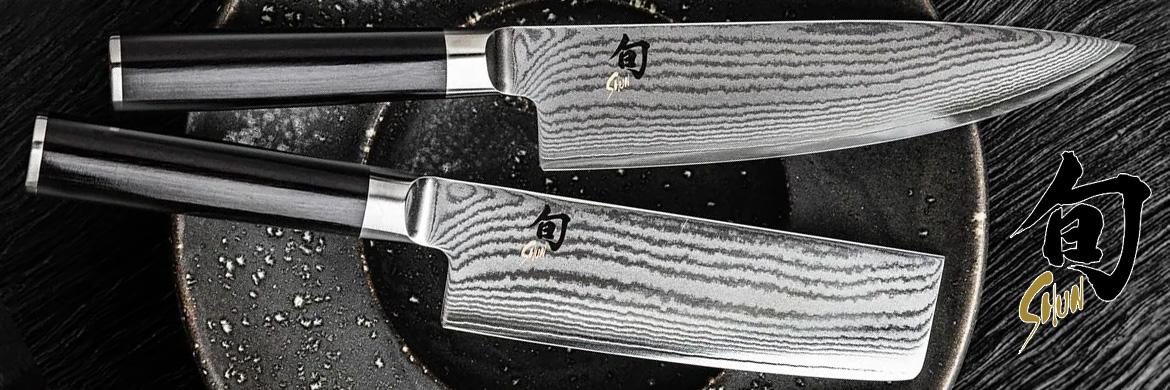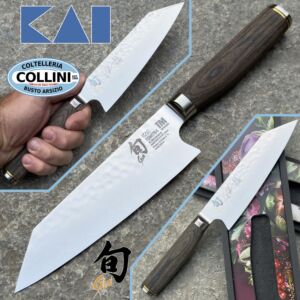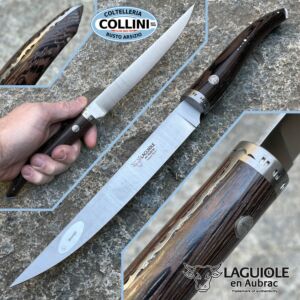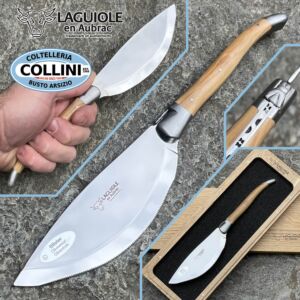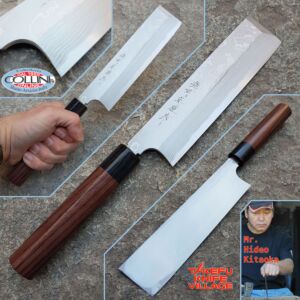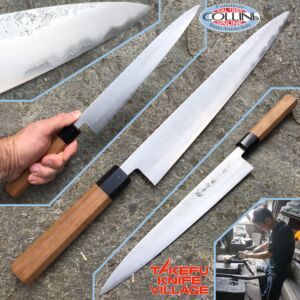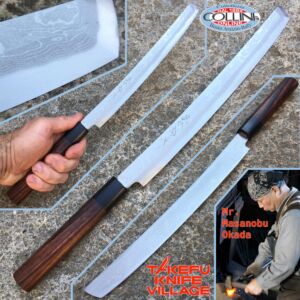Explore Professional Kitchen Knives and Chef's Knives
-
Kai Japan - Shun Premier Tim Mälzer TDM-1784 - Small Kiritsuke 15cm - 13 The Lucky Edition - kitchen knives
Kai Europe offers another exclusive collaboration with master-chef Tim Mälzer: Small Kiritsuke 13 The Lucky Edition.
A special edition with an opaque brown handle and a 15 cm hammered blade. The edition is limited to only 5555 pieces and each one is numbered. As such, each knife is a unique collector's item.
As with the previous limited edition, the Kiritsuke was chosen, but in a smaller size. This is a type of Japanese knife that combines the design and characteristics of a usuba and a yanagiba. The usuba is used for cutting vegetables and the yanagiba for raw fish, for example when making sashimi. As such, the kiritsuke can be used for many different tasks in the kitchen: cutting vegetables, meat and fish. The tanto inverted profile makes the tip very flexible and perfect for precision tasks. The flat blade is perfect for other cutting tasks.
The superbly sharp blade is made of VG MAX steel with a hardness of 61 (± 1) HRC and surrounded by 32-layer Damascus steel. The Damascus steel makes each knife unique. The matt handle of this special edition is, like the regular knives in the Tim Mälzer Premier collection, made of walnut wood: it is moisture-resistant thanks to the resin treatment. The chestnut shape of the handle is comfortable in the hand and provides a firm grip when using the knife.
Blade: Damascus stainless steel VG MAX hardness of 61±1 HRC
Handle: Matt walnut wood
Blade length: 155 mm.
Handle length: 120 mm.
Blade thickness: 1.9 mm.
Total length: 285 mm.
Weight: 151 g.
Notes: not dishwasher safe - wooden presentation boxTDM-1784 -
Laguiole en Aubrac - meat knife 20cm - Gourmet Series - Wenge - kitchen knife
Elegante linea Gourmet da cucina realizzata da Laguiole en Aubrac con manici in legno di Wenge.
La tradizionale mosca e la croce del pastore si possono vedere sul manico così come una testina tutta decorata a
mano da un artigiano esperto che ricorda così la fabbricazione del famoso coltello pieghevole Laguiole.La lama viene realizzata in acciaio inossidabile Sandik 14C28, famoso acciaio svedese di alta qualità.
Destinazione d'uso: coltello carne
Tipo di produzione: Artigianale
Produzione Lama: Francia
Lama: in acciaio 14C28
Manicatura: in legno di Wenge
Lunghezza lama: 185mm.
Spessore lama: 2mm.
Lunghezza totale: 322mm.
Peso: 139g.
Confezione: Scatola in cartoneCGO20WEI-HZB1 -
Laguiole en Aubrac - chef's knife 25cm - Gourmet Series - Wenge - kitchen knife
Elegant Gourmet kitchen line made by Laguiole en Aubrac with Wenge wood handles.
The traditional fly and the shepherd's cross can be seen on the handle as well as a fully decorated head
hand by an expert craftsman who thus remembers the manufacture of the famous Laguiole folding knife.The blade is made of Sandik 14C28 stainless steel, famous Swedish high quality steel.
Intended use: meat knife
Type of production: Artisan
Production Lama: France
Blade: 14C28 steel
Handle: in Wenge wood
Blade length: 240mm.
Blade thickness: 2mm.
Total length: 380mm.
Weight: 183g.
Packaging:CGO25WEI-HZB1 -
Laguiole en Aubrac - Set of 6 steak knives with handles in 6 different types of wood - table knives
Prestigious and elegant Laguiole En Aubrac 6-piece set with handles in 6 different woods.
- oak wood handle
- wenge wood handle
- boxwood handle
- juniper wood handle
- wooden handle in iron wood
- olive wood handle- Handcrafted realization
Blade: 12C27 Stainless Steel
Handle: in wood
Blade length: 115 mm.
Blade thickness: 3 mm.
Total length: 230 mm.Packaged in a wooden box.
6MC99QFIH -
Kai Japan - Tim Mälzer Minamo Series TMM-0700 - Paring knife 9cm. - kitchen knives
Tim Malzer - Premier Kai Shun Minamo Series
With its flawless elegance, the Shun Minamo series joins the ranks of Kai's Premier Class series. An artistic combination of different cultures brought together by Tim Malzer's idea of creating the perfect synthesis between the European chef's knife and the Japanese santoku.
This fusion is at the base of the three blades that make up the Minamo series, designed with a clear stylistic idiom.
The unique combination of dark wood grain combined with the damask steel pattern gives each single knife a unique and unrepeatable look.
The name of the series derives from the patter of the damask used for these spectacular blades that recalls the rippled surface of the water plowed by the rain (in Japanese, Minamo).
Blade: VG10 Japanese laminated steel in SanMai at 61 hrc
Handle: Black Pakkawood wood
Blade length: 90 mm.
Blade thickness: 2.2 mm.
Total length: 195 mm.
Weight: 70 g.
Notes: not dishwasher safeTMM-0700 -
Santa Fe 'Stoneworks - 4 knives set with mother of pearl inlays - table knives
Set of 4 table knives products in Germany in Solingen and edited in manicatura, with extreme care and precision, Santa Fe 'by a company specialized in the processing of precious stones
Features:
Blade: stainless steel
Blade length: 120 mm
Handle length: 110 mm
Overall length: 225 mm
Handle: mother of pearl, turquoise, cocobolo wood
Production Germany / SantaFe '
Notes: handicraftsantafe1€245.90Only 1 leftOnly 1 left -
Global knives - GS89 - Cook Knife 13.5cm - vegetable kitchen knife
All-purpose knife for meat, vegetables and small fish.
Use: meat, fish, vegetables
Blade length: 13.5 cm.
Total Length: 25 Cm.
Weight: 92 gr.GLOBAL Japanese knives are the favorite of Chefs in the most prestigious hotels and restaurants in the world.
The first GLOBAL knife was designed in 1985 by Komin Yamada, who gave the knife he created a new and revolutionary design.The main features of GLOBAL knives are:
- Lightness: GLOBAL was the first company in the world to make an empty steel knife in the handle. This feature allows you to reduce the weight of the knife by 30%.
- Manageability: thanks to the lightness and anatomical shape of the handle, GLOBAL knives lend themselves to continuous and prolonged times of use, minimizing user fatigue.
- Wire hold: GLOBAL knives are made using the best steels and the most modern manufacturing techniques. In the blades there is a high percentage of Molybdenum / Vanadium thanks to which the hardness of the steel reaches 56/58 Rockwell of hardness, consequently increasing the life of the wire.
- Sturdiness: being the GLOBAL knives completely in steel (both the handle and the blade) they are practically indestructible.
- Elegance
Awards acquired by GLOBAL knives:1990 - Japanese Good Design by MITI
1991 - Selected for International Design Year Book
1992 - Selected as Best Cooks' Knife in Benelux
1995 - Selected as Best Knife by WHICH Magazine in the UK
1996 - Selected as Sharpest Knife by A LA CARTE Magazine in GermanyAll Global products marketed by us are indelibly screen-printed with the Collini Cutlery logo (as in the image). This marking guarantees the buyer to have certainty on the quality, traceability, guarantee over the years and future privileged assistance on the product purchased from Coltelleria Collini.
GS89 -
Claude Dozorme Laguiole - 18-piece set of tableware with Bee Exotic Wood Handle
Established in 1902 by Blaise Dozorme, also referred to as "the wolf", the Claude Dozorme brand is the signature of a long and modern family tradition. The brand of Claude Dozorme, himself an anti-conformist, corroborates through the collections bearing his name, a reflection of the cultural melting pot of our society. For more than 100 years, all products have carried his name as the guarantee for quality, technical know-how and tradition. Claude Dozorme Laguiole - Set 18 pieces tableware with Bee Exotic Wood Handle This delightful set is hand finished with the utmost attention to detail, so it can withstand even the most difficult carving jobs. Made in France. Made by one of the oldest knife manufacturers in France, these knives feature a polished stainless steel blade and are of superior quality and fit. Features: 6 steak knives 6 table forks 6 table spoons High quality stainless steel blade Exotic wood handles with brass support Triple rivet Presented as a set in a Claude Dozorme wooden gift box Recommended hand wash.2543 -
Laguiole en Aubrac - cook's knife 20cm - Gourmet Series - Wenge - kitchen knife
Elegant Gourmet kitchen line made by Laguiole en Aubrac with Wenge wood handles.
The traditional fly and the shepherd's cross can be seen on the handle as well as a fully decorated head
hand by an expert craftsman who thus remembers the manufacture of the famous Laguiole folding knife.The blade is made of Sandik 14C28 stainless steel, famous Swedish high quality steel.
Intended use: meat knife
Type of production: Artisan
Production Lama: France
Blade: 14C28 steel
Handle: in Wenge wood
Blade length: 190mm.
Blade thickness: 2mm.
Total length: 330mm.
Weight: 166g.
Packaging: Cardboard boxCGO20WEI-HSB1 -
Laguiole en Aubrac - utility knife 15cm - Gourmet Series - Wenge - kitchen knife
Elegant Gourmet kitchen line made by Laguiole en Aubrac with Wenge wood handles.
The traditional fly and the shepherd's cross can be seen on the handle as well as a fully decorated head
hand by an expert craftsman who thus remembers the manufacture of the famous Laguiole folding knife.The blade is made of Sandik 14C28 stainless steel, famous Swedish high quality steel.
Intended use: vegetable / meat knife
Type of production: Artisan
Production Lama: France
Blade: 14C28 steel
Handle: in Wenge wood
Blade length: 150mm.
Blade thickness: 2mm.
Total length: 290mm.
Weight: 144g.
Packaging: Cardboard boxCGO15WEI-HZB1 -
Takefu Village - Takobiki Knife 260mm by Mr. Masanobu Okada - F-276R - kitchen knife
Takefu Knives Village is a brand born in 1991 in Echizen Fukui, a city in Japan famous since 1400 for the production of knives.
The Takefu knives brand is based on the union of 10 local artisans who make each knife by hand.The model presented is made by:
Mr. Masanobu Okada
Born in the city of Echizen in 1949, the third generation of forging artisans, he is one of the few living heirs of the "masaoki-ho" typical of Echizen, a forging technique that consists in hammering and folding the steel giving it a rhomboid shape for get a thinner, sharper and easier to sharpen steel sheet.Initially specialized in the production of agricultural tools with the Monjiro brand, in recent times he began to produce artisanal kitchen knives with the traditional "uchi-hamono" technique, also receiving the title of Dentoukougeishi (traditional craftsman) after having undergone the strict examinations of the commission of the Traditional Crafts Industry Promotion Association Foundation.
The uchi-hamono technique (uchi means blow and hamono means cutting tool) finds its origins towards the end of the 1300s, in the Muromachi period and consists of manually beating with a hammer and repeatedly a heated steel sheet until a blade of cut. Many tools made with this particular method are still on permanent display at the MoMA (Museum of Modern Art) in New York.
In a recent interview Mr. Okada said: "I have been engaged with this art for over 45 years, but still today I still think that it is an infinite world where the notions learned never become obsolete and for this I feel I have to transmit them. to the younger generations ". Currently, under his careful guidance, two apprentices are thoroughly learning the blade polishing techniques.
Characteristics of the knife:Use: meat / fish
Blade: CladSteel carbon steel with cutting edge in White Paper Steel (Shirogami) at 62 / 64HRC and damascus with 67 layers
Provenance Lama: Japanese craftsmanship
Handle: SandalWood, very hard and water resistant wood
Packaging: in cardboard with Japanese writing
Blade length: 265mm
Total length: 410mm
Blade thickness: from 3.5mm to 3mm
Handle Length: 139mm
Weight: 178g* Not every knife is signed on the blade by the craftsman who made it
Maintenance:
Considering the high carbon steel used for the blade and the extreme construction quality of these knives, we recommend a series of attentions to be followed to maintain the quality of the product over time.- Never put the knife in the dishwasher
- Rinse the knife with hot water before first use
- Rinse the knife immediately after each use without aggressive dishwashing detergent and dry with a soft cloth (always starting at the back of the cutting edge)
- Aggressive foods such as lemon juice must be promptly rinsed immediately after use
- Do not use glass or granite plates as a cutting support. Use only wooden bases
- Pay attention that the cutting edge of the knife does not come into contact with other metal objects during its storage to avoid damage to the cutting edge.
Invia commenti
Cronologia
Salvate
CommunityF-276R -
Takefu Village - Funayuki Knife 180mm - SanMai Shirogami 2 - by Mr. Masanobu Okada - kitchen knife
Takefu Knives Village is a brand born in 1991 in Echizen Fukui, a city in Japan famous since 1400 for the production of knives.
The Takefu knives brand is based on the union of 10 local craftsmen who make each knife by hand.The model presented is made by:
Mr. Masanobu Okada
Born in the city of Echizen in 1949, the third generation of forging craftsmen, he is one of the few living heirs of the "masaoki-ho" typical of Echizen, a forging technique that consists in repeating and folding the hammer steel giving it a rhomboid shape for obtain a thinner, sharper and easier to sharpen steel sheet.
Knife features:Use: meat / fish / vegetables
Blade: CladSteel carbon steel with cutting edge in White Paper Steel (Shirogami) at 62 / 64HRC and damask at 67
Lama origin: Japanese craftsmanship
Handle: Keyaki Zelkova (Japanese elm)
Packaging: cardboard with Japanese writing
Blade length: 184mm
Total length: 336mm
Blade thickness: 3.9mm
Handle length: 140mm
Weight: 179g* Not every knife is signed on the blade by the craftsman who made it
Maintenance:
Considering the high carbon steel used for the blade and the extreme construction quality of these knives, we recommend a series of attentions to follow to maintain the quality of the product over time.- Never put the knife in the dishwasher
- Rinse the knife with warm water before the first use
- Rinse the knife immediately after each use without aggressive dishwashing detergent and dry with a soft cloth (always starting at the back of the cutting edge)
- Aggressive foods such as lemon juice must be immediately rinsed immediately after use
- Do not use glass or granite slabs as a cutting support. Use only wooden bases
- Take care that the blade edge of the knife does not come into contact with other metal objects during its storage to avoid damage to the blade edge.OKD-180FUB -
Takefu Village - Kaku Usuba 170mm by Mr. Hideo Kitaoka - kitchen knife
Takefu Knives Village is a brand born in 1991 in Echizen Fukui, a city in Japan famous since 1400 for the production of knives.
The Takefu knives brand is based on the union of 10 local artisans who make every knife by hand.The model presented is realized by:
Mr. Hideo Kitaoka
Born in the city of Echizen in 1950, third generation forging craftsmen, he specializes in knives with Kataba blade (concave blade on the left side of the wire, chisel blade on the right side of the wire) also receiving the title of Dentoukougeishi (traditional craftsman) after subjected to the strict examination of the Traditional Crafts Industry Promotion Association Foundation commission.
Its knives are made with a White Paper Steel (Shirogami) cutting edge with a hardness of over 62 / 64HRC and with "Suminagashi" damask steel laminated cheeks. The handles are made as usual in sandalwood and Asian buffalo horn.
The Kanji characters printed on its blades 越 前 英雄 作 mean Echizen Hideo Saku (made by Hideo of Echizen)
Characteristics of the knife:Use: vegetables
Blade: CladSteel carbon steel with White Paper Steel (Shirogami) cutting edge at 62 / 64HRC and 33-layer "Suminagashi" damask
Provenance Lama: Japanese craft
Handle: Sandalwood, very hard and water resistant wood
Packaging: in cardboard with Japanese lettering
Blade length: 170mm
Total Length: 330mm
Blade thickness: from 4.5mm to 1.3mm
Handle Length: 134mm
Weight: 175g* Not every knife is signed on the blade by the craftsman who made it
Maintenance:
Given the high carbon content steel used for the blade and the extreme build quality of these knives, we recommend a series of attentions to follow to maintain the quality of the product over time.- Never place the knife in the dishwasher
- Rinse the knife with hot water before first use
- Rinse the knife immediately after each use without aggressive dishwashing detergent and dry with a soft cloth (always starting at the back of the cutting edge)
- Aggressive foods such as lemon juice must be promptly rinsed immediately after use
- Do not use glass or granite slabs as a cutting support. Use only wooden bases
- Pay attention that the cutting edge of the knife does not come into contact with other metal objects during its deposit to avoid damage to the cutting edge.C-106 -
Takefu Village - Sujihiki Knife 270mm by Mr. Kanehiro Kintaro - kitchen knife
Takefu Knives Village is a brand born in 1991 in Echizen Fukui, Japan's famous city since the 1400s for knives production.
The Takefu knives brand is based on the union of 10 local artisans who make every knife by hand.The model presented is made by:
Mr. Kanehiro Kintaro
Kanehiro-san knives have gained popularity among professional chefs for the highest construction level and the high performance and cutting performance.
Knife Features:Use: meat / fish
Blade: Clad Steel (Steel Hammer Forged, San Mai) Steel with Aogami cutting edge super carbon steel core 62 / 63HRC with 3 layers
Origin Knife: Japanese craftsmanship
Handle: Cherry wood
Packing: in cardboard with Japanese writing
Length Blade: 265mm
Total Length: 417mm
Thickness Blade: 4mm to 1mm
Length Grip: 137mm
Weight: 154g* Not every knife is signed on the blade by the craftsman who made it
Maintenance:
Considering the high carbon steel used for the blade and the extreme construction quality of these knives, we recommend a number of attentions to keep in order to maintain the quality of the product over time.- Never put the knife in the dishwasher
- Rinse the knife with hot water before first use
- Rinse the knife immediately after each use without detergent for aggressive crockery and dry with a soft cloth (always starting at the back of the blade wire)
- Aggressive foods such as lemon juice should be rinsed immediately after use
- Do not use glass or granite plates as a cutting support. Use only wooden bases
- Take care that the knife blade wire does not come into contact with other metallic objects during its storage to prevent damage to the blade.D-507 -
Takefu Village - Santoku Knife 180mm by Mr. Kanehiro Kintaro - kitchen knife
Takefu Knives Village is a brand born in 1991 in Echizen Fukui, Japan's famous city since the 1400s for knives production.
The Takefu knives brand is based on the union of 10 local artisans who make every knife by hand.The model presented is made by:
Mr. Kanehiro Kintaro
Kanehiro-san knives have gained popularity among professional chefs for the highest construction level and the high performance and cutting performance.
Knife Features:Use: meat / fish / vegetables
Blade: Clad Steel (Steel Hammer Forged, San Mai) Steel with Aogami cutting edge super carbon steel core 62 / 63HRC with 3 layers
Origin Knife: Japanese craftsmanship
Handle: Cherry wood
Packing: in cardboard with Japanese writing
Length Blade: 170mm
Total Length: 315mm
Thickness Blade: 4mm to 1mm
Length Grip: 125mm
Weight: 134g* Not every knife is signed on the blade by the craftsman who made it
D-503 -
Takefu Village - Petty Utility Knife 150mm by Mr. Masanobu Okada - kitchen knife
He was born in 1949 and is the 3rd generation of Okada Uchihamono. He is originally a blacksmith of gardening tools such as a sickle. In recent years, he has started to produce unique kitchen knife like your bought Takobiki. The Traditional Craftsman is the so-called Dentoukougeishi (Traditional Craftsman) which is the Accreditation Examination conducted by the Traditional Crafts Industry Promotion Association Foundation in accordance with Section 8 of Section 24 of the Act on Promotion of Traditional Craft Industries
Knife Features:
Use: vegetables / meat / fish
Blade: CladSteel carbon steel with 62 / 64HRC White Paper Steel (Shirogami) cutting edge and 33-layer Damask "Suminagashi"
Origin Knife: Japanese craftsmanship
Handle: SandalWood, very hard and water resistant
Packing: in cardboard with Japanese writing
Blade Length: 150mm
Total Length: 275mm
Thickness Blade: 3mm
Length Grip: 114mm
Weight: 86gF-211 -
Takefu Village - Petty Utility Knife 120mm by Mr. Masanobu Okada - kitchen knife
He was born in 1949 and is the 3rd generation of Okada Uchihamono. He is originally a blacksmith of gardening tools such as a sickle. In recent years, he has started to produce unique kitchen knife like your bought Takobiki. The Traditional Craftsman is the so-called Dentoukougeishi (Traditional Craftsman) which is the Accreditation Examination conducted by the Traditional Crafts Industry Promotion Association Foundation in accordance with Section 8 of Section 24 of the Act on Promotion of Traditional Craft Industries
Knife Features:
Use: vegetables / meat / fish
Blade: CladSteel carbon steel with 62 / 64HRC White Paper Steel (Shirogami) cutting edge and 33-layer Damask "Suminagashi"
Origin Knife: Japanese craftsmanship
Handle: SandalWood, very hard and water resistant
Packing: in cardboard with Japanese writing
Length Blade: 120mm
Total Length: 245mm
Thickness Blade: 3mm
Length Grip: 114mm
Weight: 78gF-209 -
Takefu Village - Takobiki Knife 270mm by Mr. Masanobu Okada - kitchen knife
He was born in 1949 and is the 3rd generation of Okada Uchihamono. He is originally a blacksmith of gardening tools such as a sickle. In recent years, he has started to produce unique kitchen knife like your bought Takobiki. The Traditional Craftsman is the so-called Dentoukougeishi (Traditional Craftsman) which is the Accreditation Examination conducted by the Traditional Crafts Industry Promotion Association Foundation in accordance with Section 8 of Section 24 of the Act on Promotion of Traditional Craft Industries
Knife Features:
Use: meat / fish
Blade: CladSteel carbon steel with 62 / 64HRC White Paper Steel (Shirogami) cutting edge and 33-layer Damask "Suminagashi"
Origin Knife: Japanese craftsmanship
Handle: SandalWood, very hard and water resistant
Packing: in cardboard with Japanese writing
Length Blade: 265mm
Total Length: 410mm
Thickness Blade: 3.5mm to 3mm
Length Grip: 139mm
Weight: 162gF-416 -
Takefu Village - Deba 180mm by Mr. Hideo Kitaoka - kitchen knife
Mr. Hideo Kitaoka
He was born in 1950 and is the 3rd generation of Kitaoka Hamono. He has been a specialist of Kataba (single-beveled) knife from the beginning. He is also Dentoukougeishi.
Knife Features:Use: chicken / fish / meat
Blade: CladSteel carbon steel with 62 / 64HRC White Paper Steel (Shirogami) cutting edge and 33-layer Damask "Suminagashi"
Origin Knife: Japanese craftsmanship
Handle: SandalWood, very hard and water resistant
Packing: in cardboard with Japanese writing
Length Blade: 180mm
Total Length: 335mm
Thickness Blade: 9mm to 2mm
Length Grip: 134mm
Weight: 336g* Not every knife is signed on the blade by the craftsman who made it
C-106D -
Takefu Village - Yanagiba Sashimi Knife 270mm by Mr. Hideo Kitaoka - kitchen knife
Mr. Hideo Kitaoka
He was born in 1950 and is the 3rd generation of Kitaoka Hamono. He has been a specialist of Kataba (single-beveled) knife from the beginning. He is also Dentoukougeishi.Use: meat / fish
Blade: CladSteel carbon steel with 62 / 64HRC White Paper Steel (Shirogami) cutting edge and 33-layer Damask "Suminagashi"
Origin Knife: Japanese craftsmanship
Handle: SandalWood, very hard and water resistant
Packing: in cardboard with Japanese writing
Length Blade: 257mm
Total Length: 410mm
Thickness Blade: 4mm to 1.5mm
Length Grip: 139mm
Weight: 184g* Not every knife is signed on the blade by the craftsman who made it
C-804 -
Takefu Village - Yanagiba Sashimi Knife 240mm by Mr. Hideo Kitaoka - kitchen knife
Mr. Hideo Kitaoka
He was born in 1950 and is the 3rd generation of Kitaoka Hamono. He has been a specialist of Kataba (single-beveled) knife from the beginning. He is also Dentoukougeishi.Use: meat / fish
Blade: CladSteel carbon steel with 62 / 64HRC White Paper Steel (Shirogami) cutting edge and 33-layer Damask "Suminagashi"
Origin Knife: Japanese craftsmanship
Handle: SandalWood, very hard and water resistant
Packing: in cardboard with Japanese writing
Length Blade: 230mm
Total Length: 375mm
Thickness Blade: 3.5mm to 1.5mm
Length Grip: 132mm
Weight: 134g* Not every knife is signed on the blade by the craftsman who made it
C-803 -
Takefu Village - Yanagiba Sashimi Knife 210mm by Mr. Hideo Kitaoka - kitchen knife
Mr. Hideo Kitaoka
He was born in 1950 and is the 3rd generation of Kitaoka Hamono. He has been a specialist of Kataba (single-beveled) knife from the beginning. He is also Dentoukougeishi.Knife Features:
Use: meat / fish
Blade: CladSteel carbon steel with 62 / 64HRC White Paper Steel (Shirogami) cutting edge and 33-layer Damask "Suminagashi"
Origin Knife: Japanese craftsmanship
Handle: SandalWood, very hard and water resistant
Packing: in cardboard with Japanese writing
Blade Length: 200mm
Total Length: 343mm
Thickness Blade: 3.5mm to 1.5mm
Length Grip: 127mm
Weight: 114g* Not every knife is signed on the blade by the craftsman who made it
C-802 -
Takefu Village - Kamausuba Knife 180mm by Mr. Hideo Kitaoka - kitchen knife
Mr. Hideo Kitaoka
He was born in 1950 and is the 3rd generation of Kitaoka Hamono. He has been a specialist of Kataba (single-beveled) knife from the beginning. He is also Dentoukougeishi.Knife Features:
Use: vegetable / fish
Blade: CladSteel carbon steel with 62 / 64HRC White Paper Steel (Shirogami) cutting edge and 33-layer Damask "Suminagashi"
Origin Knife: Japanese craftsmanship
Handle: SandalWood, very hard and water resistant
Packing: in cardboard with Japanese writing
Length Blade: 170mm
Total Length: 320mm
Thickness Blade: 4mm to 2mm
Length Grip: 132mm
Weight: 166g* Not every knife is signed on the blade by the craftsman who made it
C-827 -
Takefu Village - Kiritsuke Knife 240mm by Mr. Hideo Kitaoka - kitchen knife
Mr. Hideo Kitaoka
He was born in 1950 and is the 3rd generation of Kitaoka Hamono. He has been a specialist of Kataba (single-beveled) knife from the beginning. He is also Dentoukougeishi.
Knife Features:Use: meat / fish
Blade: CladSteel carbon steel with 62 / 64HRC White Paper Steel (Shirogami) cutting edge and 33-layer Damask "Suminagashi"
Origin Knife: Japanese craftsmanship
Handle: SandalWood, very hard and water resistant
Packing: in cardboard with Japanese writing
Length Blade: 240mm
Total Length: 375mm
Thickness Blade: 4mm to 2mm
Length Grip: 127mm
Weight: 160g* Not every knife is signed on the blade by the craftsman who made it
C-751 -
Takefu Village - Kiritsuke Knife 210mm by Mr. Hideo Kitaoka - kitchen knife
Mr. Hideo Kitaoka
He was born in 1950 and is the 3rd generation of Kitaoka Hamono. He has been a specialist of Kataba (single-beveled) knife from the beginning. He is also Dentoukougeishi.
Knife Features:Use: meat / fish
Blade: CladSteel carbon steel with 62 / 64HRC White Paper Steel (Shirogami) cutting edge and 33-layer Damask "Suminagashi"
Origin Knife: Japanese craftsmanship
Handle: SandalWood, very hard and water resistant
Packing: in cardboard with Japanese writing
Length Blade: 210mm
Total Length: 345mm
Thickness Blade: 4mm to 2mm
Length Grip: 127mm
Weight: 150g* Not every knife is signed on the blade by the craftsman who made it
C-750 -
Laguiole en Aubrac - Sep 6 piece wooden handle steak knives - table knives
Presitigioso and elegant set of 6 Laguiole en Aubrac with handles in six different woods.
- In applewood handle
- Juniper wood handle
- Boxwood handle
- Walnut handle
- In Plum wood handle
- Olive wood handlehandcrafted
Blade: Steel 12C27 Stainless Steel
Handle: Wood
Blade length: 115 mm.
Blade thickness: 3 mm.
Overall length: 230 mm.Packed in wooden box.
62C99BFIH -
Takeshi Saji - Miyabi Kenryu - Coltello Artigianale
Takeshi Saji è nato nel 1948 a Takefu (prefettura di Fukui), una città situata all'incirca nel centro del Giappone e nel cuore di una zona da secoli votata alla produzione di lame. Il suo laboratorio è ancora lì, costruito intorno al forno grazie al quale, ormai da parecchi anni, Takeshi Saji forgia l'acciaio (soprattutto damasco) con cui realizza vari modelli di coltelli tradizionali giapponesi. La scelta dei materiali per le finiture (prevalentemente naturali), le linee essenziali - evocatrici dell'utilizzo - e gli accostamenti cromatici di raro impatto rendono le sue realizzazioni uniche e inconfondibili nel panorama della coltelleria mondiale e, in patria, gli sono valse il prestigioso titolo di Maestro.
Destinazione d'uso: Collezione/Sportivo
Tipo di produzione: Artigianale
Produzione Lama: Giappone
Lama: Forgiata a mano, in damasco laminato con tagliente in Hitachi Shirogami a 64HRC
Trattamento Lama: -
Manicatura: Sakura (legno di ciliegio)
Lunghezza lama: 130mm.
Spessore lama: 4.5mm.
Lunghezza chiuso: -
Lunghezza totale: 245mm.
Spessore da chiuso: -
Bilanciatura: -
Peso: 172g.
Chiusura: -
Clip: -
Fodero: Cuoio e Sakura (legno di ciliegio)
Confezione: Scatola di cartone
Note: interamente realizzati a mano da Takeshi Saji4011 -
Takeshi Saji - Miyabi Hayabusa - custom knife
Takeshi Saji è nato nel 1948 a Takefu (prefettura di Fukui), una città situata all'incirca nel centro del Giappone e nel cuore di una zona da secoli votata alla produzione di lame. Il suo laboratorio è ancora lì, costruito intorno al forno grazie al quale, ormai da parecchi anni, Takeshi Saji forgia l'acciaio (soprattutto damasco) con cui realizza vari modelli di coltelli tradizionali giapponesi. La scelta dei materiali per le finiture (prevalentemente naturali), le linee essenziali - evocatrici dell'utilizzo - e gli accostamenti cromatici di raro impatto rendono le sue realizzazioni uniche e inconfondibili nel panorama della coltelleria mondiale e, in patria, gli sono valse il prestigioso titolo di Maestro.
Destinazione d'uso: Collezione/Sportivo
Tipo di produzione: Artigianale
Produzione Lama: Giappone
Lama: Forgiata a mano, in damasco laminato con tagliente in Hitachi Shirogami a 64HRC
Trattamento Lama: -
Manicatura: Sakura (legno di ciliegio)
Lunghezza lama: 110mm.
Spessore lama: 5mm.
Lunghezza chiuso: -
Lunghezza totale: 215mm.
Spessore da chiuso: -
Bilanciatura: -
Peso: 134g.
Chiusura: -
Clip: -
Fodero: Cuoio e Sakura (legno di ciliegio)
Confezione: Scatola di cartone
Note: interamente realizzati a mano da Takeshi Saji4012

